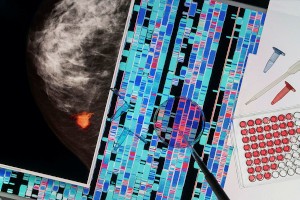Edited by:
Shicong Tang, MD, Yunnan Cancer Hospital, China
Submission Status: Open | Submission Deadline: 10 June 2025

Image credit: © VOISIN / PHANIE / Science Photo Library

Shicong Tang, MD, Yunnan Cancer Hospital, China

Image credit: © VOISIN / PHANIE / Science Photo Library

Breast cancer research has significantly advanced in understanding cellular mechanisms and identifying crucial biomarkers for diagnosis, prognosis, and treatment. Further exploration is necessary to delve into the complexities of breast cancer progression, metastasis, and treatment responses. This collection will showcase pioneering research utilizing single-cell transcriptomics to reveal novel biomarkers and elucidate cellular mechanisms underpinning breast cancer progression and treatment responses. The studies will encompass both in vitro and in vivo research, focusing on metabolic and immunological heterogeneity within the tumour microenvironment. Additionally, it seeks to explore how these insights can be translated into potential therapeutic targets and predictive markers for the efficacy of immunotherapy and chemotherapy, thereby bridging the gap between laboratory findings and clinical strategies.
The collection scope includes, but is not limited to, the following topics:
• Biomarker identification and validation
• Tumour heterogeneity in breast cancer
• Signalling pathways and molecular mechanisms
• In vitro and in vivo models for breast cancer research
• Single-cell analysis and its implications
• Therapeutic targets and personalized medicine.
The immune checkpoint targeting is nowadays an integral part of cancer therapies. However, only a minority of patients experience long-term benefits. Thus, the identification of predictive biomarkers contribut...
Tumor-associated macrophages (TAMs) are pivotal components of the breast cancer (BC) tumor microenvironment (TME), significantly influencing tumor progression and response to therapy. However, the heterogeneit...
Cancer-associated fibroblasts (CAFs) are highly heterogeneous cells and important components of the breast tumor microenvironment (TME). However, their role and clinical value in ER-positive breast cancer have...
Ferroptosis is a therapeutic strategy for breast carcinoma (BC). Solasonine (SS) was linked to ferroptosis as a tumor suppressor. However, whether SS could treat BC by activating ferroptosis and its underlying...
Breast cancer remains the most prevalent malignancy and the leading cause of cancer-related mortality among women worldwide. The primary factors contributing to the deterioration and death of patients with bre...
Bromodomain-containing protein (BRD) play a pivotal role in the development and progression of malignant tumours. This study aims to identify prognostic genes linked to BRD-related genes (BRDRGs) in patients w...
The tertiary lymphoid structure (TLS) is recognized as a potential prognosis factor for breast cancer and is strongly associated with response to immunotherapy. Inducing TLS neogenesis can enhance the immunoge...
Gas therapy represents a promising strategy for cancer treatment, with nitric oxide (NO) therapy showing particular potential in tumor therapy. However, ensuring sufficient production of NO remains a significa...
The objective of this study was to compare the efficacy and safety of subsequent chemotherapy with single eribulin or utidelone combined with a capecitabine regimen in patients with advanced breast cancer who ...
This study aimed to compare the performance of amide proton transfer–weighted imaging (APTWI) and diffusion kurtosis imaging (DKI) in differentiating benign from malignant breast lesions, evaluate molecular su...
As a common cause of cancer-related deaths in women, BRCA (breast cancer) shows complexity and requires precise biomarkers and treatment methods. This study delves into the molecular makeup of BRCA, focusing o...
Breast cancer remains a leading cause of mortality among women worldwide, necessitating innovative prognostic models to enhance treatment strategies.
Breast cancer has become the malignant tumor with the first incidence and the second mortality among female cancers. Most female breast cancers belong to luminal-type breast cancer and HER2-positive breast can...
Breast cancer is currently the most frequent malignant tumor and the leading cause of cancer death among women globally. Although the five-year survival rate for early breast cancer has risen to more than 90%,...
Tumor metastasis is a continuous and dynamic process and is a major cause of tumor-related death in triple-negative breast cancer. However, this biological process remains largely unknown in triple-negative br...
Currently, there are no optimal biomarkers available for distinguishing patients who will respond to immune checkpoint inhibitors (ICIs) therapies. Consequently, the exploration of novel biomarkers that can pr...
This Collection welcomes submission of original Research and Review articles. Should you wish to submit a different article type, please read our submission guidelines to confirm that type is accepted by the journal.
Articles for this Collection should be submitted via our submission system, Snapp. Please, select the appropriate Collection title “Novel Biomarkers and Cellular Mechanisms in Breast Cancer: Insights from In Vitro and In Vivo Single-Cell Studies" under the “Details” tab during the submission stage.
Articles will undergo the journal’s standard peer-review process and are subject to all the journal’s standard policies. Articles will be added to the Collection as they are published.
The Editors have no competing interests with the submissions which they handle through the peer-review process. The peer-review of any submissions for which the Editors have competing interests is handled by another Editorial Board Member who has no competing interests.